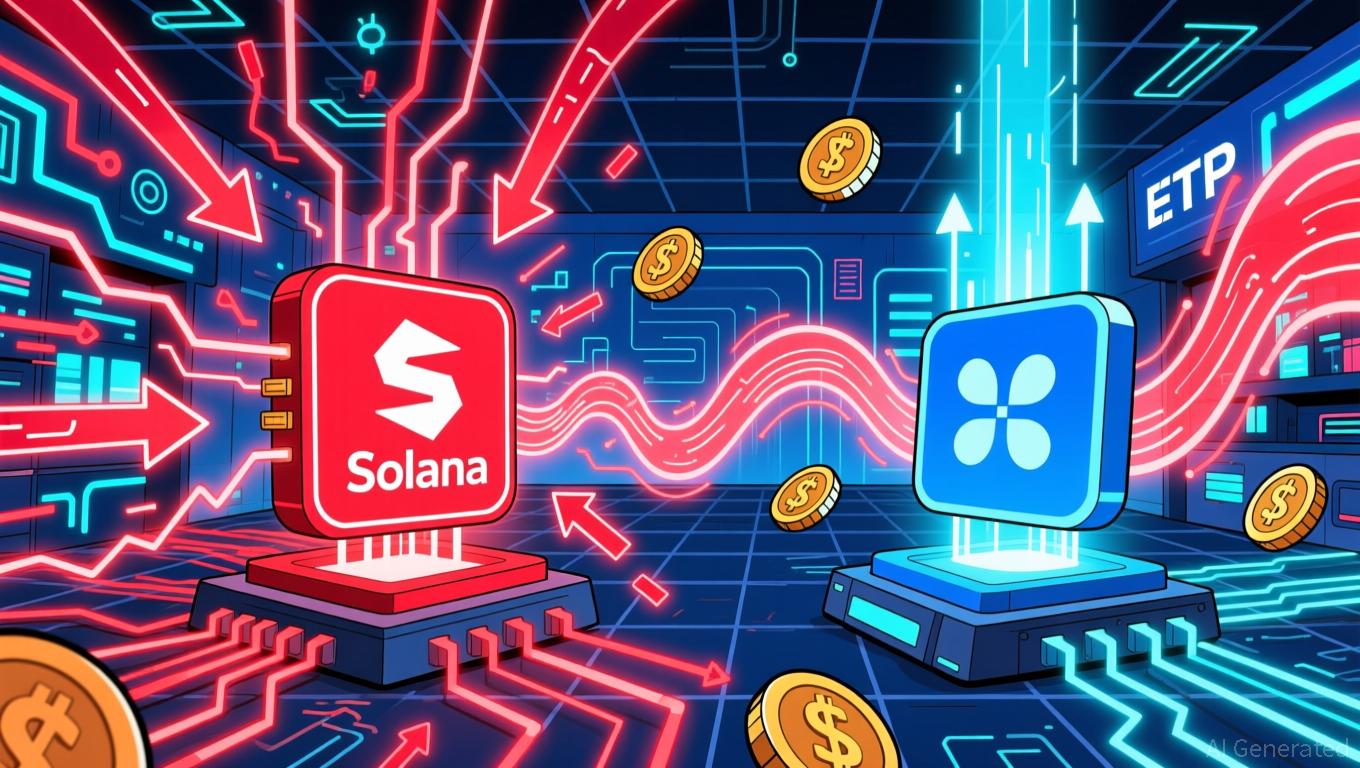"From Initial Coin Offerings to Gaining Institutional Confidence: The Transformation of Crypto Tokenomics"
- Canton’s tokenomics strategy rejects ICOs, promoting structured, long-term crypto development models to enhance institutional credibility and sustainability. - Regulatory delays like Switzerland’s postponed CARF and U.S. ETF approvals highlight challenges in aligning innovation with compliance and cross-border legitimacy. - Grayscale’s Dogecoin and XRP ETFs signal growing institutional acceptance, though mixed market performance underscores crypto’s volatility and speculative risks. - Advocacy groups lik
Evolving Tokenomics in the Crypto Industry
Canton’s approach to tokenomics, which deliberately avoids short-term speculative token sales, signals a broader movement within the cryptocurrency sector toward more deliberate and sustainable growth models. Unlike earlier projects that depended on swift token sales for funding—often attracting criticism for speculative behavior—Canton’s strategy reflects a commitment to long-term stability and institutional trust. This trend is mirrored in initiatives such as Bitcoin Munari’s phased launch on Solana, which emphasizes a capped supply of 21 million BTCM and compatibility with EVM infrastructure. These frameworks are designed to foster confidence through openness, a necessity as regulatory oversight becomes increasingly stringent worldwide.
Regulatory Shifts and Market Impacts
Recent regulatory changes highlight the hurdles that crypto ventures must overcome. For example, Switzerland has postponed the rollout of the Crypto-Asset Reporting Framework (CARF) until 2027, underscoring the difficulties of harmonizing innovation with regulatory requirements. The nation’s tax authorities have yet to determine which countries will participate in data sharing, leaving projects that seek international legitimacy in a state of uncertainty. In the United States, the crypto environment is rapidly transforming, with the New York Stock Exchange recently approving Grayscale’s Dogecoin and XRP exchange-traded funds (ETFs). These new ETFs, now available for trading, mark a significant step toward mainstream acceptance of digital assets, though their performance has varied—XRP, for instance, has seen an 18% drop since November.
Governance, Community, and Political Advocacy
The scope of tokenomics now encompasses not just technical architecture but also governance and community involvement.

Efforts like Stand With Crypto’s initiative to evaluate 2026 political candidates based on their stance toward digital assets demonstrate the growing importance of political advocacy in the crypto space. By supporting candidates who favor crypto-friendly policies, such groups aim to influence regulatory frameworks that encourage innovation. This aligns with Canton’s own strategy of retaining control over token distribution and minimizing exposure to short-term market swings—a move that appeals to investors seeking greater stability in a traditionally volatile industry.
Industry Growth Through Partnerships and Innovation
The maturation of the blockchain and crypto sectors is further evidenced by strategic collaborations and acquisitions. Hydreight Technologies’ acquisition of a 5% stake in Perfect Scripts, LLC—with the potential to expand to 40%—illustrates how blockchain enterprises are vertically integrating to bolster supply chain efficiency and data protection. This partnership, which features a pharmacy network compliant with HIPAA standards, highlights blockchain’s role in improving transparency and regulatory adherence in healthcare logistics. Likewise, Profound Medical’s introduction of an AI-driven BPH module at medical conferences showcases the intersection of blockchain and artificial intelligence in advancing healthcare solutions. These examples indicate that tokenomics is increasingly being applied to practical, real-world scenarios beyond the financial sector.
The Road Ahead: Balancing Innovation and Oversight
As the crypto landscape continues to evolve, the relationship between tokenomics, regulation, and market trends will shape the industry’s future. Projects like Canton, which favor structured development, may become models for achieving both innovation and investor security. With the rise of ETFs and growing institutional involvement, the sector’s capacity to adapt to regulatory changes—such as Switzerland’s CARF delay—will be crucial. At the same time, advocacy groups and business alliances are redefining the political and operational environment, ensuring that the growth of digital assets remains both robust and sustainable.
Disclaimer: The content of this article solely reflects the author's opinion and does not represent the platform in any capacity. This article is not intended to serve as a reference for making investment decisions.
You may also like
ETPs Connect Speculative Tokens with Traditional Financial Markets
- Swiss firm Bitcoin Capital launched Europe's first Bonk ETP on SIX, enabling traditional investors to trade the Solana-based memecoin via conventional financial tools. - Physically-backed ETP eliminates crypto expertise requirements, aligning with global altcoin product surges and U.S. altcoin ETF trends. - Market shift toward speculative assets reflects regulatory clarity and institutional interest, with European regulators cautiously embracing crypto-ETP bridges. - Projects like Kuardun7.0 aim to merge

The transformation of the Xerox campus in Webster, NY: A calculated move in real estate and infrastructure development
- Webster , NY's Xerox campus redevelopment leverages a $9.8M FAST NY grant to upgrade 300 acres of brownfield infrastructure, creating shovel-ready industrial space by 2025. - Xerox's strategic divestiture aligns with infrastructure timelines, enabling private-sector repurposing of the site as a mixed-use hub with anchor projects like the $650M fairlife® dairy plant. - State-backed upgrades have already driven 10.1% annual home price growth and 2% industrial vacancy rates, positioning the site to capture

Ethereum News Update: Amundi’s Integrated Approach Connects Blockchain with Conventional Financial Regulations
- Amundi, Europe's largest asset manager, launched its first Ethereum-based tokenized money-market fund, enabling 24/7 settlements and transparent record-keeping via blockchain. - The hybrid model, developed with CACEIS, combines traditional fund operations with blockchain-based ownership, preserving regulatory compliance while expanding investor access. - Ethereum's dominance in stablecoin and RWA transfers ($105.94B in 30 days) underscores its role in accelerating tokenization, with Amundi positioning it

XRP News Today: XRP ETFs Drive Price Increases, While Solana ETFs Ease Selling Pressure
- XRP ETFs raised $587M in inflows since late November, outpacing Solana's $568M as investors favor altcoins with regulatory clarity and utility. - Bitwise XRP ETF's $107M debut and zero-fee strategy drove momentum, while Solana ETFs faced $156M weekly outflows due to network reliability concerns. - XRP's inflows acted as a "battering ram" pushing prices above $2.27, contrasting Solana's ETFs which merely dampened sell pressure without reversing its decline. - Analysts predict XRP could reach $3 by Decembe
